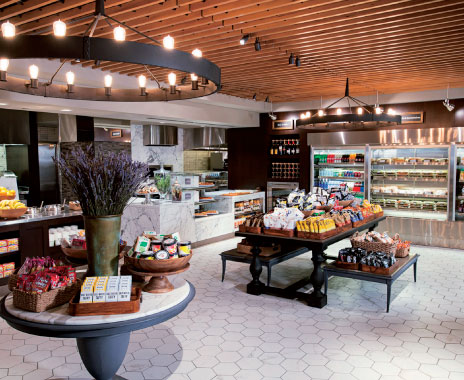Consumer demand for more convenient, healthier foods has affected the quick-service industry for the last several years. Now the trend might be helping to create a new competitor for traditional quick-serve brands: hotels.
Hotel food offerings were once minimal, unhealthy, or expensive, sending guests elsewhere for their meals. But today, hotels at every price point are positioning themselves to compete with surrounding restaurants, offering new menus, foodservice hours, and grab-and-go options.
Adam Glickman is head of the InterContinental Hotels Group’s (ihg) new Even Hotels brand, the first wellness lifestyle hotel at a mainstream price point. IHG’s research, he says, shows an increasing need for a hotel experience that is both healthier and more affordable. IHG’s “The Kinship Economy: From Travel Experiences to Travel Relationships’” report, published in March 2013 in conjunction with the Futures Company, identified key trends expected to take shape in the next decade.
“One trend highlighted focused on supporting travelers who seek greater control—whether that relates to how they work, eat, communicate, or anything else,” Glickman says. “The demand for healthier options that still taste great is key. For so long, ‘healthy’ dining meant having a light beer or salad with tasteless dressing. We know that people want to feel good about what they eat and drink, but don’t want to sacrifice flavor.”
Even Hotels’ Market concept offers guests freshly prepared food and other pre-packaged grab-and-go items, available 24/7, as well as “Go” options, which are balanced meals guests can pre-order at night and pick up the next morning as they leave.
Business travelers represent a large percentage of the time-crunched guests whose on-the-road lifestyle requires fast dining options, a market also increasingly targeted by IHG brand Crowne Plaza.
“We are testing a few enhancements that allow our guests to grab something quickly so they can focus on getting their work done,” says Gina LaBarre, vice president of Americas brand management and upscale brands with IHG. She adds that the company tested the enhancements for several months in the Americas region. “Based on the results, next year we will begin rolling out the ‘Energy Essentials’ enhancement, which provides quick and easy access to healthy snacks and beverages for purchase. We are further testing the ‘Breakfast to Go’ and ‘Fast and Fresh Menu Options’ enhancements as part of a larger global food and beverage strategy.”
Within the healthier, more convenient hotel foodservice initiatives, there are many additional food trends taking root. Kimpton Hotels, for example, is embracing a number of popular trends by adding gluten-free, vegetarian, and vegan options to its menus.
“We’re hearing more and more from guests that they’re looking for foods that are packed with nourishing ingredients or super foods that help to fuel them,” says John Inserra, senior vice president of restaurant operations for Kimpton Hotels. “This summer we also launched new healthy in-room dining menus, where each of our chefs denotes dishes that are healthy or will provide an energy boost by noting it with a rocket logo by the dish name.”
Hilton’s new Herb N’ Kitchen concept, which offers take-away and in-room options, is also incorporating several food trends, including a seasonal menu, regional specialties (in New York, for example, guests can order “baked in Brooklyn” pita chips and a Murray’s cheese plate), and locally sourced ingredients.
“Guests want to eat local,” says Beth Scott, vice president of global products for F&B and wellness at Hilton Worldwide, “and they should be able to do that right inside their hotel.”
Even Hotels is also meeting the kaleidoscope of wellness demands with a menu that addresses a range of diet styles, including choices that are heart healthy, low fat, vegetarian, and even friendly to a paleo diet, which focuses intensely on meats, seafood, vegetables, fruits, and nuts.
In addition to redeveloping their foodservice operations to incorporate a variety of healthier options, hotels are now communicating their wellness commitment to guests.
“The biggest trend we have included in our food and beverage platform is transparency,” Glickman says. “We know that our guests want to have confidence that what they are eating is what a restaurant or retailer says it is from a product and nutritional standpoint. Through [our] research, we identified a number of brands our guests are comfortable with; they will recognize products available in the market from their favorite healthy or organic grocery store.”
As hotel foodservice options continue to incorporate more convenient and healthy options, they threaten to steal business from quick serves that might otherwise attract hotel guests looking for a fresh bite. But consumers are still conditioned to pick up food before checking in, experts interviewed for this story say, a behavior hotels are trying to change.
Social media is helping. A new app, menumodo, allows hotels to display their menus in a user-friendly format on their websites and on Facebook so prospective guests can learn about the foodservice opportunities before checking in.
“Surprisingly, a lot of hotels still do not display menus on their own websites due to the limitations of their content management systems,” says Michael Madison, menumodo’s founder and CEO. “[With] menus and other information on hotel F&B outlets across all platforms, visitors spend more time on websites, do not have to look elsewhere for information, and feel more comfortable
with the offering.”
Despite hotels’ move toward healthier and fresher food options, nutritionist Nicole Maftoum, author of the blog “Eat Like a Dietitian,” says there are a few additional steps they should take if they want to pose a legitimate threat to quick-service restaurants.
“When I think about hotels, three wishes come to my mind: breakfast buffets to include the option of customizing a healthy omelet, and healthy bread choices; room service that includes a category of nutritious salads, and, in the mini bar, portion-sized healthy snacks such as 23 pieces of almonds, dried cranberries, etc.,” she says.



